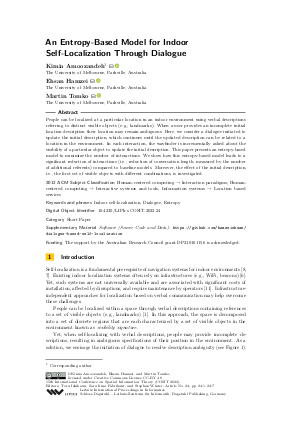An Entropy-Based Model for Indoor Self-Localization Through Dialogue (Short Paper)
Authors
Kimia Amoozandeh  ,
Ehsan Hamzei
,
Ehsan Hamzei  ,
Martin Tomko
,
Martin Tomko 
-
Part of:
Volume:
15th International Conference on Spatial Information Theory (COSIT 2022)
Part of: Series: Leibniz International Proceedings in Informatics (LIPIcs)
Part of: Conference: Conference on Spatial Information Theory (COSIT) - License:
 Creative Commons Attribution 4.0 International license
Creative Commons Attribution 4.0 International license
- Publication Date: 2022-08-22
File

PDF
LIPIcs.COSIT.2022.24.pdf
- Filesize: 1.93 MB
- 7 pages
Document Identifiers
Subject Classification
ACM Subject Classification
- Human-centered computing → Interaction paradigms
- Human-centered computing → Interactive systems and tools
- Information systems → Location based services
Keywords
- Indoor self-localization
- Dialogue
- Entropy
Metrics
- Access Statistics
-
Total Accesses (updated on a weekly basis)
0Document
0Metadata
Abstract
People can be localized at a particular location in an indoor environment using verbal descriptions referring to distinct visible objects (e.g., landmarks). When a user provides an incomplete initial location description their location may remain ambiguous. Here, we consider a dialogue initiated to update the initial description, which continues until the updated description can be related to a location in the environment. In each interaction, the wayfinder is incrementally asked about the visibility of a particular object to update the initial description. This paper presents an entropy-based model to minimize the number of interactions. We show how this entropy-based model leads to a significant reduction of interactions (i.e., reduction of conversation length, measured by the number of additional referents) compared to baseline models. Moreover, the effect of the initial description, i.e., the first set of visible objects with different combinations, is investigated.
Cite As Get BibTex
Kimia Amoozandeh, Ehsan Hamzei, and Martin Tomko. An Entropy-Based Model for Indoor Self-Localization Through Dialogue (Short Paper). In 15th International Conference on Spatial Information Theory (COSIT 2022). Leibniz International Proceedings in Informatics (LIPIcs), Volume 240, pp. 24:1-24:7, Schloss Dagstuhl – Leibniz-Zentrum für Informatik (2022)
https://doi.org/10.4230/LIPIcs.COSIT.2022.24
BibTex
@InProceedings{amoozandeh_et_al:LIPIcs.COSIT.2022.24,
author = {Amoozandeh, Kimia and Hamzei, Ehsan and Tomko, Martin},
title = {{An Entropy-Based Model for Indoor Self-Localization Through Dialogue}},
booktitle = {15th International Conference on Spatial Information Theory (COSIT 2022)},
pages = {24:1--24:7},
series = {Leibniz International Proceedings in Informatics (LIPIcs)},
ISBN = {978-3-95977-257-0},
ISSN = {1868-8969},
year = {2022},
volume = {240},
editor = {Ishikawa, Toru and Fabrikant, Sara Irina and Winter, Stephan},
publisher = {Schloss Dagstuhl -- Leibniz-Zentrum f{\"u}r Informatik},
address = {Dagstuhl, Germany},
URL = {https://drops.dagstuhl.de/entities/document/10.4230/LIPIcs.COSIT.2022.24},
URN = {urn:nbn:de:0030-drops-169095},
doi = {10.4230/LIPIcs.COSIT.2022.24},
annote = {Keywords: Indoor self-localization, Dialogue, Entropy}
}
Author Details
Funding
The support by the Australian Research Council grant DP210101156 is acknowledged.
Supplementary Materials
- Software (Source Code and Data) https://github.com/hamzeiehsan/dialogue-based-self-localization
References
- Kimia Amoozandeh, Stephan Winter, and Martin Tomko. Space decomposition based on visible objects in an indoor environment. Environment and Planning B: Urban Analytics and City Science, 49(3):883-897, 2022. URL: https://doi.org/10.1177/23998083211037347.
- Harm de Vries, Kurt Shuster, Dhruv Batra, Devi Parikh, Jason Weston, and Douwe Kiela. Talk the walk: Navigating new york city through grounded dialogue. arXiv preprint, 2018. URL: http://arxiv.org/abs/1807.03367.
-
Vojtech Gintner, Jan Balata, Jakub Boksansky, and Zdenek Mikovec. Improving reverse geocoding: Localization of blind pedestrians using conversational ui. In 2017 8th IEEE International Conference on Cognitive Infocommunications (CogInfoCom), pages 000145-000150. IEEE, 2017.

- Arthur C. Graesser and Natalie K. Person. Question asking during tutoring. American Educational Research Journal, 31(1):104-137, 1994. URL: https://doi.org/10.3102/00028312031001104.
-
Hua Hua, Peng Zhang, and Jochen Renz. Qualitative place maps for landmark-based localization and navigation in gps-denied environments. In Proceedings of the 27th ACM SIGSPATIAL International Conference on Advances in Geographic Information Systems, pages 23-32, 2019.

- Germán Martín Mendoza-Silva, Joaquín Torres-Sospedra, and Joaquín Huerta. A Meta-Review of Indoor Positioning Systems. Sensors, 19(20), 2019. URL: https://doi.org/10.3390/s19204507.
- Daniel R Montello. Navigation. In The Cambridge Handbook of Visuospatial Thinking., pages 257-294. Cambridge University Press, 2005. URL: https://doi.org/10.1017/CBO9780511610448.008.
-
Urs-Jakob Rüetschi and Sabine Timpf. Modelling Wayfinding in Public Transport: Network Space and Scene Space. In Spatial Cognition IV. Reasoning, Action, Interaction, pages 24-41, 2005.

-
Paolo Sernani, Sergio Vagni, Nicola Falcionelli, Dagmawi Neway Mekuria, Selene Tomassini, and Aldo Franco Dragoni. Voice interaction with artworks via indoor localization: A vocal museum. In International Conference on Augmented Reality, Virtual Reality and Computer Graphics, pages 66-78. Springer, 2020.

- C. E. Shannon. A mathematical theory of communication. The Bell System Technical Journal, 27(3):379-423, 1948. URL: https://doi.org/10.1002/j.1538-7305.1948.tb01338.x.
- Stephan Winter, Martin Tomko, Maria Vasardani, Kai-Florian Richter, Kourosh Khoshelham, and Mohsen Kalantari. Infrastructure-Independent Indoor Localization and Navigation. ACM Comput. Surv., 52(3), June 2019. URL: https://doi.org/10.1145/3321516.
